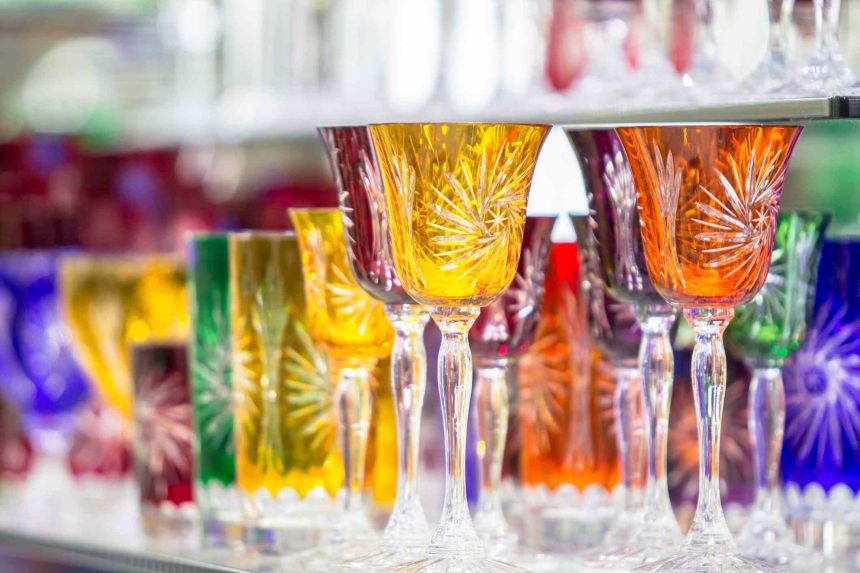If you collect vintage glassware, you’ve probably come across beautifully colored cut crystal in saturated hues of red, orange, blue, and green. This deeply colored stemware gives off midcentury vibes, but its history actually goes back to the Renaissance and production that began in Bohemia in the Czech Republic.
This colorful cut glassware is a type of bohemia crystal and here’s what you need to know about its history, the colors, where to source it, how to style it, and whether you can put it in the dishwasher.
- Whitney Cardozo is the chef and proprietress of Chez Foushee in Richmond, VA and the owner of vintage glassware shop, Chez at Home.
What Is Bohemia Cut Crystal?
Bohemia cut crystal is intricately cut crystal stemware that comes in a range of colors, including many which are absent of color completely. However, some of the most recognizable and sought after bohemia crystal stemware is found in richly saturated, vivid colors. It’s instantly recognizable thanks to its vibrant hues and sparkling detail, and authentic bohemia crystal’s color is in the crystal itself—it’s never painted on.
The Origins Of Colorful Bohemia Cut Crystal
Colorful cut crystal’s story goes back to the Renaissance, when it first began to appear in the Czech Republic—specifically Boehemia. Royals across Europe quickly became fans of the striking stemware, and its production continued throughout the centuries.
In modern day, bohemia cut crystal in vibrant colors like blue and red became popular around midcentury. While this crystal glassware is still manufactured today, many of the sets available date from that era.
Bohemia Crystal Colors
Ruby red, cobalt blue, emerald green, and deep orange are a few of the colors you’ll commonly see in colored bohemia crystal, though it comes in every color from an electric lime green to a rich royal purple to a playful pink. “I tend to favor amber and green, which I believe are hallmark colors of vintage Bohemia cut glass,” says Cardozo.
Authentic bohemia crystal’s colors are incredibly saturated and vibrant. “The colors are amazing and make a statement! Because of their vivid, rich color you don’t need many to make an impression,” explains Cardozo.
Getty Images / alessandro0770
Where To Source Vintage Colored Crystal
This vibrant cut crystal stemware is increasingly on the radar of collectors, and standard sets of six glasses can command prices of $100 and up, while others can run $100 or more per glass. “It’s amazing what you can find at yard and estate sales, but I frequently come across this type of cut glass on most online auction, e-shops,” explains Cardozo.
You can also find it at higher end antique stores, where it’s often curated by color or sold in sets with one of each sparkling color. Nachtmann, Ajka, and Beyer.
Cardozo recommends paying attention to the pattern, cuts or etchings in the stemware to make sure you’re buying authentic bohemia crystal. “The devil is a little bit in the details, but it is worth taking a close look at the color and the pattern.” Authentic bohemia crystal should have intricate, clear cuts.
If you do find yourself scanning a dusty thrift store shelf hoping for a treasure, there’s still hope. Cardozo says, “I find that Bohemia cut glass with its rich jewel tones can be overlooked because many people are looking for clear crystal stemware and some shy away from color.”
Replacements, Ltd
Incorporating Bohemia Crystal Into A Tablescape
The beauty of bohemia cut crystal is that the range of colors work with tablescapes year round. The cobalt blue, ruby red, and emerald green are gorgeous for a festive Christmas tablescape, while pink, green, and purple are perfect for a spring occasion or Easter.
You can choose one standout color in a wine glass or water glass to anchor a tablescape, then use solid glassware for the rest of the table or you can choose several colors to bring together in a rainbow of glittering crystal. Choose dishes or china that has multiple colors in the pattern, then pull several out with different colored bohemia crystal glasses. This is the time to lean into saturation and more is more.
“One of my guiding principles is if nothing matches, then nothing clashes! I recommend coordinating your existing dishes and linens to complement these eye-catching pieces,” says Cardozo.
Replacements, Ltd.
Taking Care Of Bohemia Crystal
With vintage glassware, washing by hand is typically the safest bet. Even if your dishwasher has a delicate cycle, it’s not worth the risk of weakening or damaging the fragile glass.
Instead, Cardozo recommends placing a tea towel in the sink, washing the crystal in lukewarm water with a mild detergent, and polishing it with a lint-free towel.
But Cardozo insists that, despite hand washing with just a little bit more care, that doesn’t mean you should keep bohemia crystal stored away on a high-up shelf, never to be used or handled. “Beautiful glassware can make some people anxious, and it often gets reserved for special occasions, which usually means ‘do not touch,'” says Cardozo. “Take a deep breath. You don’t need to wear white gloves. It’s important to embrace the fact that things can and probably will break. Enjoy them now!”








